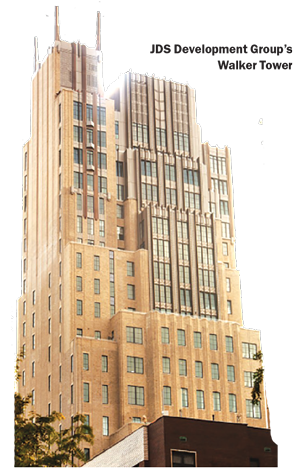Like Manhattan’s jagged skyline, the history of its real estate industry is shaped by steep rises and swift falls. There is William Zeckendorf, who rose from small-time broker to seminal developer of the 1950s and 1960s only to die bankrupt. Decades later, Harry Macklowe rose from college dropout to real estate mogul, lost it all in the 2007 downturn and landed back on his feet in the years after.
The latest developer to climb the industry’s peak at breakneck speed is Michael Stern, the 36-year-old head of JDS Development Group.
Stern began building his first low-rise properties in the outer boroughs just 16 years ago. Now he is co-developing the tallest building in the Western Hemisphere at 111 West 57th Street and the tallest building on the East Coast outside of Manhattan at 9 DeKalb Avenue in Brooklyn — as well as three other New York high-rises.
 When you tally in the buildings JDS and its partners have already completed — such as Walker Tower in Chelsea and Stella Tower in Hell’s Kitchen — you’d be hard-pressed to find many other developers leaving a bigger mark on the city’s skyline in today’s market.
When you tally in the buildings JDS and its partners have already completed — such as Walker Tower in Chelsea and Stella Tower in Hell’s Kitchen — you’d be hard-pressed to find many other developers leaving a bigger mark on the city’s skyline in today’s market.
But JDS isn’t just building more than its peers, it is also taking on more risk at a time when the luxury residential market is showing signs of slowing and lending volume is contracting.
A fellow high-rise developer, speaking on condition of anonymity, said he “doesn’t understand the economics” behind 111 West 57th, which JDS is co-developing with Property Markets Group on Billionaire’s Row, the nexus of the luxury condo boom.
Even as far back as 2014 industry players were expressing concern about the level of development taking place on the stretch. In November of that year, Stonehenge Partners CEO Ofer Yardeni said he “would very happily short 57th Street.” Yardeni did not return a request for comment for this story.
And skepticism surrounding Billionaire’s Row has been growing lately as the highest echelon of the luxury market has softened.
“What strikes me is how aggressively he brings buildings to the market at a time when people are getting concerned,” Louis Coletti, head of the Building Trades Employers’ Association and a frequent opponent of non-union developers such as Stern, told The Real Deal. “History shows [the market] can’t continue this pace of growth over time.”
The two projects that will make or break JDS’s standing as one of New York’s great development firms are its tallest and boldest. But a look at the cost structures of the projects shows how thin the line between success and failure may be.
The Steinway Gamble
When PMG founder Kevin Maloney told Bloomberg in April that 111 West 57th would hold off on marketing condos for at least a year, due to slowing demand, he seemed to prove all the project’s doubters right.
The tower will include 60 condos with asking prices averaging $5,700 per square foot, according to an offering plan.
 But despite slowing demand for high-priced units and increased competition at the top of the market, JDS and its partners remain optimistic that the development will succeed, according to sources involved in the project’s financing.
But despite slowing demand for high-priced units and increased competition at the top of the market, JDS and its partners remain optimistic that the development will succeed, according to sources involved in the project’s financing.
That’s partly because the tower is not scheduled to be complete until early 2018 and the developers’ construction loans don’t mature until mid-2019, meaning they can wait for the luxury market to recover. And even if it doesn’t, JDS and PMG are betting that a comparatively low cost basis will protect them financially.
“I think they, and we, still feel very comfortable with the basis,” Scott Weiner, head of Apollo Global Management’s commercial real estate debt business and a mezzanine lender on the project, told analysts during a February earnings call. “I can’t speak to their strategy in terms of how they want to approach presales, but they don’t have to sell anything right now.”
The developers estimate the glass-and-steel tower will cost between $2,300 and $2,500 per square foot to build, while the project’s break-even is only a little higher than that, around $2,800, according to sources in the know. That gives JDS and PMG a nice cushion against a possible market downturn.
By comparison, Extell’s condo tower One57, which is nearly sold out, and CIM Group and Harry Macklowe’s 432 Park Avenue, which is selling now, reportedly cost well above $3,000 per square foot to build. Meanwhile Vornado Realty Trust’s 220 Central Park South is expected to cost a staggering $5,000 per square foot.
Aaron Appel, a broker at commercial firm JLL who arranged financing for 111 West 57th, said the comparatively low price the developers paid for the land cannot be overlooked.
JDS and PMG assembled the project by buying a development site as well as the operating lease on the neighboring, landmarked Steinway Building and going through a complicated landmarks approval process. The co-developers paid $131.5 million for the site, or around $400 per buildable square foot, according to property records.
In recent years, JDS has become the most high-profile New York development firm to use non-union labor in order to keep its construction costs down — and it’s done so unapologetically. The company largely handles construction on its projects in-house through its JDS Construction Group, a decision that continues to draw ire from unions.
Still, JDS’s and PMG’s ambitiously low costs and their use of non-union labor comes with plenty of risk.
Construction attorney Barry LePatner said that while non-union contractors have made strides in the past decade, they generally have less experience in ultra-high-rise construction.
 “There are certain developers who don’t want that risk on their projects,” he said. “Clearly Gary Barnett and Extell don’t want that risk [at One57].”
“There are certain developers who don’t want that risk on their projects,” he said. “Clearly Gary Barnett and Extell don’t want that risk [at One57].”
Meanwhile, Maloney told the project’s equity investor AmBase Corporation in the fall of 2015 that 111 West 57th was “significantly over-budget and delayed,” according to a lawsuit AmBase filed against JDS and PMG in April. (The suit alleges that the co-developers “devised a scheme to increase their ownership interest in the joint venture at the expense of AmBase” through unnecessary capital calls. AmBase is seeking $104.8 million in damages.)
Representatives for JDS and PMG did not return a request for comment to elaborate.
But if delays and cost overruns persist the developers could be facing a serious problem.
JDS and PMG funded the project with about $130 million in equity, a $400 million senior loan from insurer AIG and a $325 million mezzanine loan from Apollo, according to sources and public records. But that may fall short of what is needed if costs balloon.
Unlike the private equity giant and 432 Park co-developer CIM — which manages $18.8 billion in equity on behalf of its investors — JDS and PMG don’t appear to have near-bottomless cash reserves.
In fact, all three partners on the 57th Street tower have reportedly had issues meeting capital calls.
AmBase failed to meet past draw downs for the project, according to the holding company’s filings with the U.S. Securities and Exchange Commission. Maloney also missed at least one capital call, court documents show. Both partners saw their equity stakes cut as a result.
And JDS met its own share of the capital calls only with financing from a third party, AmBase claimed in its court filings.
But bringing in more outside funding — or even refinancing existing loans — could prove challenging if the debt markets continue to lose steam.
Brooklyn’s tallest
Across the East River in Brooklyn, JDS and the Chetrit Group are working on a similarly ambitious project: the 1,066-foot-tall mixed-use tower at 9 DeKalb that would shatter the borough’s height record by around 400 feet. The project won landmarks approval in April.
Here, too, Stern managed to assemble the site on the cheap.
In June 2014, he and Chetrit bought the development site at 340 Flatbush Avenue for $43.5 million. Then in December 2014, the adjacent, landmarked Dime Savings Bank hit the market along with 285,000 square feet of air rights.
JDS and Chetrit were in the best position to buy the bank site “because no one else could use the air rights,” Ofer Cohen, founder of Brooklyn-based investment sales brokerage TerraCRG, told TRD. The developers paid $90 million for the building and filed plans for a 556,000-square-foot tower. The two deals put the developers’ cost basis at roughly $240 per gross buildable square foot — versus the much higher $350 to $400 per buildable square foot that sites in the area often trade for, according to data from TerraCRG.
“Their basis is really attractive and enables them to do either rental or condo,” Cohen said, adding that the retail space in the historic Dime Savings Bank will likely provide another major revenue source.
Still, JDS and Chetrit face plenty of risk.
 The developers funded their acquisition and pre-development costs of 9 DeKalb with a $115 million loan from Fortress Credit, a subsidiary of the private equity firm Fortress Investment Group. Though the terms of the debt were not disclosed, Fortress has a reputation as a hard money lender with a strong appetite for risk. The firm subsequently sold a portion of the loan to Kushner Companies for $57.5 million, making company head and fellow real estate wunderkind Jared Kushner one of Stern’s lenders.
The developers funded their acquisition and pre-development costs of 9 DeKalb with a $115 million loan from Fortress Credit, a subsidiary of the private equity firm Fortress Investment Group. Though the terms of the debt were not disclosed, Fortress has a reputation as a hard money lender with a strong appetite for risk. The firm subsequently sold a portion of the loan to Kushner Companies for $57.5 million, making company head and fellow real estate wunderkind Jared Kushner one of Stern’s lenders.
“We looked at the basis and pricing and thought it would be a great risk-adjusted investment,” Laurent Morali, a managing director and head of acquisitions and capital markets at Kushner Companies, told TRD.
But some sponsors have had a hard time accessing the capital to complete construction. This year alone, two high-profile New York developers defaulted on acquisition and pre-development loans because they were unable to secure construction financing: Bruce Eichner at 1800 Park Avenue in East Harlem and Joseph Beninati at 3 Sutton Place.
JDS and Chetrit aren’t yet in the market for a construction loan, according to sources, but they will need to secure one to replace the financing from Fortress.
JLL’s Appel said he’s not worried about Stern landing a construction loan for the project. “Look, any large construction loan right now is challenging,” he said. “But I don’t see him having any more challenging of a time that any other developer.”
Boom or bust?
Despite credit market headwinds, there are plenty of observers who believe JDS will succeed with its latest projects.
“They know what they are doing and they are building in good locations,” said Clipper Equity principal David Bistricer.
Bistricer — who is not working with JDS but was partnered with Chetrit at the Sony Building until the two sold the tower for $1.3 billion and abandoned condo-conversion plans — argued that fears of a condo market downturn are overblown. He said financing is still available for the right projects and noted that interest rates are still affordable by historical standards.
 “There’s plenty of money in the marketplace,” he told TRD. “[Banks] do have choices but at end of day they have to write checks.”
“There’s plenty of money in the marketplace,” he told TRD. “[Banks] do have choices but at end of day they have to write checks.”
Others pointed to Stern’s skills as a developer and noted that he got to where he is on his own — without inheriting any of his wealth.
And numerous sources described him as highly knowledgeable and generally well respected in the industry.
In an interview with TRD earlier this year, Stern said the biggest misconception people have about him is “that I’m very young and sort of showed up overnight.”
“I don’t think they realize I’ve been grinding it out since I was 20 years old,” he added.
Appel said Stern’s “overall ability to control the development process” has been a factor in winning over lenders.
“I think at first blush it’s a hard sell because of Michael’s age, but anybody that spends time getting to know him and his business walks away impressed,” he said. “He has an innate ability to manage all the components and bring out the best in people.”
And David von Spreckelsen, president of rival developer Toll Brothers City Living, commended Stern, saying he “knows the zoning resolutions probably better than most architects and lawyers in the city.”
Still, some observers worry that Stern may lack the track record to take on so many projects at a time of high market uncertainty. The abovementioned anonymous developer called Stern’s roster of projects “an awful lot for someone who is, relatively speaking, not that experienced.”
The flipside is that if Stern succeeds, he will secure his place in the pantheon of New York’s most influential developers at a remarkably young age.
Von Spreckelsen dismissed the suggestion that Stern is taking on too many projects and argued that completing 111 West 57th and 9 DeKalb will solidify Stern’s reputation as one of the city’s most ambitious developers.
“That’s a good number, but Gary Barnett does a good number of projects, too,” he said. “I don’t see age having any factor. If anything that’s a good thing. He has the energy and ambition to do it.”
